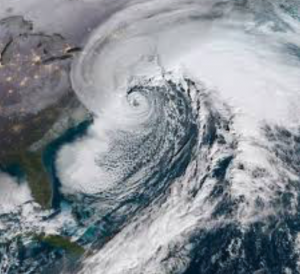
Every so often, weather events can turn extreme and impact areas for a few days, weeks, or months. In October 2012, Hurricane Sandy caused floods, power outages, fuel shortages, and many other inconveniences to everyday life. Annually, severe weather such as ice storms, snow storms, heavy sustained rains, and significant temperature swings are all part and parcel of seasonal and unseasonal weather patterns. During these weather events, the building enclosure of any structure is the front line and primary protection of the building. It is particularly helpful to be proactive about planning for maintenance and repairs that could prevent significant damage during future extreme weather events.
Nor’easters are wind-driven rain or snow events that primarily impact buildings along the north and east-facing elevations. High winds can blow rainwater and/or snow sideways, and sometimes a vortex occurs with multidirectional gusts. This phenomenon can challenge the watertight integrity of any façade system, including fenestrations, known as openings in the wall systems. These openings are typically protected with sealant joints. It is quite common for Nor’easters to cause the saturation of the building elements such as brick, mortar, and other water-permeable features. If the water saturation is followed by freezing temperatures, the impact is compounded since freeze-thaw cycles can be quite damaging to masonry building elements.
Ice storms may be caused by rain that falls into a sub-freezing temperature layer before making contact with the ground. During these sub-freezing temperatures, ice may form on A/C units and other building appurtenances. When the temperature rises, significant ice build-up may break off with the potential to impale building elements including roof system membranes, skylights, and other vulnerable areas on building roof setbacks.
Wet and dense snowfall, especially from a sudden, heavy accumulation, can add significant load to appurtenances, balconies, and light-capacity roof systems. Appurtenances that are most impacted are canopies attached to buildings and similar attachments. A freeze-thaw period with dense snow is likely to form ice within the snow accumulation.
Heavy sustained rains can overwhelm roof and terrace drains, causing a bathtub effect. On occasion, a heavy rain storm is capable of overwhelming wall membrane flashing and vulnerable seams in the roof membrane systems. When that occurs, there can be delayed interior leaks.
Metals and alloys expand and contract, but when joined with dissimilar materials, those joints are placed under stress by extreme temperatures. The most vulnerable points of a building are those joints between dissimilar materials. These joints are typically bridged with sealants, including bond breaker tape, as well as closed- and open-cell foam as backer material. Closed-cell foam has very minimal expansion and contraction while quality open-cell foam can typically be expanded and contracted up to 100% of its relaxed state.
During and after significant weather events, it is common to have reported leaks. It is also common that these leaks may be difficult to recreate if the existing systems are typically watertight. The proactive way to avoid unnecessary and preventable failures at the façades, windows, and roof systems, is to have comprehensive building envelope surveys performed. Surveys can provide the basis for a detailed maintenance and repair or restoration program to address exteriors that are vulnerable to failure.
